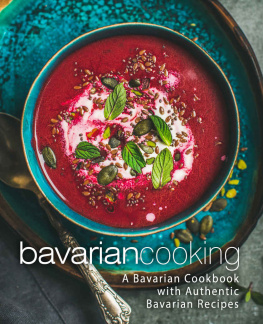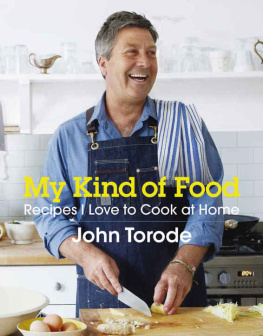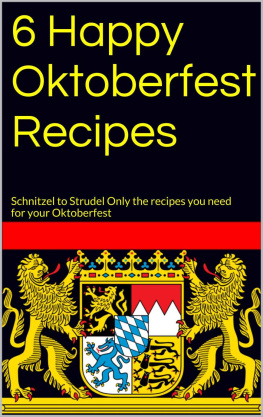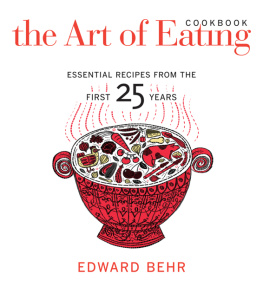www.edwardblom.se/in-english
www.twitter.com/edward_blom
www.youtube.com/edwardblom
www.instagram.com/edward_blom
Copyright 2013 by Edward Blom and Norstedts, Stockholm English translation 2014 by Skyhorse Publishing First published by Norstedts, Sweden in 2013 as Allting gott och alldeles fr mycket by Edward Blom. Published by agreement with Norstedts Agency.
Photography by Eva Hildn Smith
Graphic design by Wickholm Design Dept.
Other photographs: p. 17 privately owned, p. 61 the Blom family, p. 71 Gunilla Kinn Blom, p. 82 Bjrn Markusson, p. 83 Bjrn Markusson (1), TV3 (2), Ulf Berglund (3), Elias sterberg (4), Pernilla Thelaus/TV3 (5), p. 184 Gunilla Kinn Blom
All Rights Reserved. No part of this book may be reproduced in any manner without the express written consent of the publisher, except in the case of brief excerpts in critical reviews or articles. All inquiries should be addressed to Skyhorse Publishing, 307 West 36th Street, 11th Floor, New York, NY 10018.
Skyhorse Publishing books may be purchased in bulk at special discounts for sales promotion, corporate gifts, fund-raising, or educational purposes. Special editions can also be created to specifications. For details, contact the Special Sales Department, Skyhorse Publishing, 307 West 36th Street, 11th Floor, New York, NY 10018 or .
Skyhorse and Skyhorse Publishing are registered trademarks of Skyhorse Publishing, Inc., a Delaware corporation.
www.skyhorsepublishing.com
10 9 8 7 6 5 4 3 2 1
Library of Congress Cataloging-in-Publication Data is available on file.
Print ISBN: 978-1-62914-700-0
Ebook ISBN: 978-1-63220-026-6
Cover design by Owen Corrigan
Skyhorse edition edited by Constance Renfrow and Amy Li
Printed in the United States of America
Contents
Dear Reader,
I am so happy that my first cookbook now exists in English and will therefore be accessible to an international audience!
In Sweden, I am a gastronomist and food historian, well-known from TV and other media platforms. In the English-speaking world, I hope that my recipes and stories will be appreciated in their own right.
Some of the dishes I present here are my inventions; others are my interpretations of culinary classics, while some are collected from friends, family and historical cookbooks. The Swedish cuisine dominates, but German, British, American, French, and Asian cooking are also important sources of my inspiration.
My wife, Gunilla, and I love to entertain guests. So we are very proud that the Gourmand World Cookbook Awards jurythe Oscars of food awardsgave this book a second prize in the Best Entertaining Cookbookcategory earlier this year.
Welcome to our culinary universe, and remember: life is indeed a banquet!
Edward Blom
Stockholm, October 2014
Editor's Note:
American unit conversions have been added throughout this book for the ease of the user. Every effort has been made to keep the measurements exact. In some cases, the cook may wish to round off a measurement for convenience. We leave this up to the judgment of the cook. When baking or making sauces it is best to stick to the exact measurements to ensure success, but for most cooking, slight variations in ingredient amounts will still yield delicious results.

My love for food!
For as long as I can remember, I have loved food. When I was three years old, my mother walked in on me heating frozen buns in the oven all by myself with the explanation that: Its tastier this way... When I was six years old, Grandpa resolutely put a padlock on the pantry, and my favorite game of Pantry boy (where, sitting beneath my sisters desk, I filled Dixie cups with different combinations from the pantry and ate one after the other) ended forever.
With seven years to my name, I shocked the school doctor when, during a conversation about my weight, he asked what my favorite dishes were and I recited: Crab, crayfish, filet mignon, Veal Oscar, plaice, bami goreng, cheese fondue, port wine marinated roast beefand above all the large cheese buffet at the Hotel Anglais! The doctor (who thought all children answered that question with what they were used to eating, and not what the greatest food experiences of their lives had been) looked at my father in astonishment and asked: How are you managing your household finances?
For just as long as I have been passionate about food, I have been fascinated by how the flavors and consistencies develop in the kitchen. My dad in particular allowed me to take part in the cooking, even when I was a small, messy child. When I reached school age, I learned from Grandma the mysteries behind old-fashioned home cooking. Sometimes even Mom would let me take part, even though she had the responsibility of day-to-day cooking and therefore had less patience.
From around ten years of age I was fascinated by cookbooks, a couple of specimens of Swedens Allt om mat (All About Food) magazine, and the odd cooking show that existed in those days (the best was a black and white rerun where Erik Bullen Berglund, a classic Swedish food expert, described how to fry entrecote). I gladly locked myself in the kitchen for hours on Saturday nights, and then the family was invited to a multicourse dinner. For my parents, I would have brought up at least one bottle of Larsens express wine from the cellar and had frothed milk for the cappuccino. And since then, I've kept going. Ive cooked food for large parties, made cheese fondue over a fire pit at medieval reenactments, made seven-course feasts in student dorm kitchens, read cookbooks, visited restaurants, copied, tested, and experimented.
After almost ten years as a student in the humanities, I started working at Swedens Center for Business History in 1997. Since then, the historical aspects of food and drink have come into focus even more. I have researched and written about breweries, dairies, Swedish arrack punsch, the grocery business, city hotels, and much more. The past five or six years Ive also made quite a few TV and radio appearances about cooking and food history, but more about that on p. 80. I give lectures and write articles about everything from sm rg sbord to pea soup, and I also combine lectures with tastings of arrack punsch, spiced brnnvin, or cheese.
I am, however, not a trained chef and have never worked at a restaurant. I can indeed create lovely flavors but I often use the wrong terminology, am unaware of many things professionals view as self-evident, and I always leave the kitchen in chaos when Im done. But this has its advantagesone of which is that my recipes are created in regular, cramped kitchens with only the basic equipment. So dont blame outside circumstances; with enough dedication, you too can prepare these dishes! My goal is that everyone who uses this book will experience the same joy I do when I am enjoying cooking and eating my favorite dishes.

Edward Blom
Stockholm, Spring 2013
















